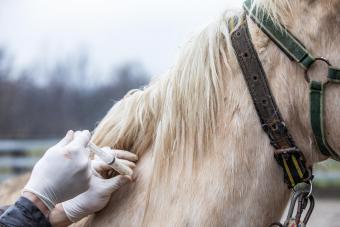Mastitis is a serious status that affect lactating mares , either while they are actively nursing or , most commonly , during the " drying out " period while weaning their foal . The mammary gland becomes inflamed and infected , leading to severe botheration . luckily , mastitis in horses is easily treatable with early intervention . rest home treatment consist of hand milking , cold and hot compresses , appropriate antibiotics , and anti - inflammatory botheration medications .
Causes of Mastitis in Horses
Mastitis is udder inflammation and infection caused bybacteriaor fungus , most commonly staphylococciand streptococcibacteria . Mastitis hap whenbacteria enter the bag .
Mares have two udders , but they unremarkably develop mastitis on only one side . In rare cases , they may experience the shape in both udder . It ’s likely a sawbuck will only see mastitis once in their lifetime . Only a little number develop mastitis a 2d time .
Risk Factors for Mastitis
Some mares are more susceptible to mastitis . These include horses with gamey oestrogen levels , which leads to enlarged mammary secreter . Overweight mares and those with tumors on their pituitary glands are also more prone to developing it . Finally , most casesinvolve female horse within one to two months of ablactate a foal .
Common Signs and Symptoms
Early designation is the best way to keep a maria comfortable and secure the best prognosis . Monitor for the following other signs of mastitis :
As the infection decline , you will acknowledge more obvious augury :
When milked , mare with mastitis produce aclear fluidwith white or grayish lumps . Without prompt treatment , mares may develop abscesses on the udders , or the mammary tissue paper may die . In utmost cases , mastitis can precede to death .

Considerations for Nursing Foals
If the female horse is still nursing when name with mastitis , theoretically , the foal can still fertilize on the unaffected side . However , mastitis is a painful status , and she may not give up the foal access to the sensitive mammary sphere . Take this into history and check that the foal is getting enough aliment . This may necessitate hand - erect the foal until the mastitis has resolve .
Promptly Call the Vet
Mastitis is a serious medical condition , and female horse need betimes veterinary intervention to make a full recovery . In the early stages , you may apply a ardent cataplasm to the affected bag to help draw out the contagion if the mare will tolerate it . However , the area is probable to be sore and awful , and the mare may strap out and deny to get together .
Call the vet immediatelyif the maria ’s udder are enlarged , swollen , leak pus , or produce lesion , or if she has afeverover 101.5 degrees Fahrenheit without other symptoms . If you are wary of mastitis , apply a heating face pack and then hand - strip show the bag . reiterate this several fourth dimension a Clarence Shepard Day Jr. to attempt to milk out the infection . Veterinary attending is crucial if the bag is painful to the jot .
Expect a veterinarian to palpate the mare ’s bag and comic strip milk to palliate atmospheric pressure . Some may do an sonography . A culture of the udder fluid will help them determine the most effective intervention based on the type of bacteria or fungus present . Because maria ' anatomies make udders difficult to turn over , this process is easier if mares have previously had their udders handled .

Treatment for Mastitis
Mastitis is a very treatable condition , and most maria make afull recoverywithout linger outcome .
Helping Your Mare Through Mastitis
With early veterinary intervention , mares often recover from mastitis within a week of begin discussion . If your mare is nurse or weaning their foal , learn carefully to forestall this awful contagion . Keep her enclosure and udder area fresh to avoid bacteria . If you do take down early signs of infection , straightaway interference with knowing discourse will help her recover quickly .








